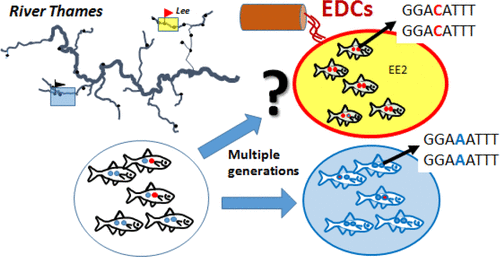当前位置:
X-MOL 学术
›
Environ. Sci. Technol.
›
论文详情
Our official English website, www.x-mol.net, welcomes your
feedback! (Note: you will need to create a separate account there.)
Investigation into Adaptation in Genes Associated with Response to Estrogenic Pollution in Populations of Roach (Rutilus rutilus) Living in English Rivers
Environmental Science & Technology ( IF 10.8 ) Pub Date : 2020-11-23 , DOI: 10.1021/acs.est.0c00957 Patrick B. Hamilton 1, 2 , Anne E. Lockyer 3 , Tamsyn M. Uren Webster 1, 4 , David J. Studholme 1 , Josephine R. Paris 1 , Alice Baynes 3 , Elizabeth Nicol 3 , Deborah A. Dawson 5 , Karen Moore 1 , Audrey Farbos 1 , Susan Jobling 3 , Jamie R. Stevens 1 , Charles R. Tyler 1
Environmental Science & Technology ( IF 10.8 ) Pub Date : 2020-11-23 , DOI: 10.1021/acs.est.0c00957 Patrick B. Hamilton 1, 2 , Anne E. Lockyer 3 , Tamsyn M. Uren Webster 1, 4 , David J. Studholme 1 , Josephine R. Paris 1 , Alice Baynes 3 , Elizabeth Nicol 3 , Deborah A. Dawson 5 , Karen Moore 1 , Audrey Farbos 1 , Susan Jobling 3 , Jamie R. Stevens 1 , Charles R. Tyler 1
Affiliation

|
Exposure of male fish to estrogenic substances from wastewater treatment works (WwTWs) results in feminization and reduced reproductive fitness. Nevertheless, self-sustaining populations of roach (Rutilus rutilus) inhabit river stretches polluted with estrogenic WwTW effluents. In this study, we examine whether such roach populations have evolved adaptations to tolerate estrogenic pollution by comparing frequency differences in single-nucleotide polymorphisms (SNPs) between populations sampled from rivers receiving either high- or low-level WwTW discharges. SNPs within 36 “candidate” genes, selected for their involvement in estrogenic responses, and 120 SNPs in reference genes were genotyped in 465 roaches. There was no evidence for selection in highly estrogen-dependent candidate genes, including those for the estrogen receptors, aromatases, and vitellogenins. The androgen receptor (ar) and cytochrome P450 1A genes were associated with large shifts in allele frequencies between catchments and in individual populations, but there is no clear link to estrogen pollution. Selection at ar in the effluent-dominated River Lee may have resulted from historical contamination with endocrine-disrupting pesticides. Critically, although our results suggest population-specific selection including at genes related to endocrine disruption, there was no strong evidence that the selection resulted from exposure to estrogen pollution.
中文翻译:

居住在英国河流中的蟑螂(Rutilus rutilus)种群对雌激素污染响应基因的适应研究。
废水处理厂(WwTWs)将雄鱼暴露于雌激素中会导致女性化并降低生殖健康。尽管如此,蟑螂的自我维持种群(Rutilus rutilus)居住在被雌激素WwTW废水污染的河段。在这项研究中,我们通过比较从接受高水平或低水平WwTW排放的河流采样的种群之间的单核苷酸多态性(SNP)的频率差异,来检查此类蟑螂种群是否已进化适应性以耐受雌激素污染。在465只蟑螂中对36个“候选”基因中的SNP进行了基因分型,这些基因被选择参与雌激素反应,而参考基因中的120个SNP被基因分型。没有证据表明可以选择高度依赖雌激素的候选基因,包括雌激素受体,芳香酶和卵黄蛋白原的候选基因。雄激素受体(AR)和细胞色素P450 1A基因与集水区之间和个别人群中等位基因频率的大变化有关,但与雌激素污染没有明确的联系。在以废水为主的李河(River Lee)进行ar的选择可能是由于历史上受到内分泌干扰农药的污染。至关重要的是,尽管我们的研究结果表明特定人群的选择包括与内分泌干扰有关的基因,但没有强有力的证据表明该选择是由于暴露于雌激素污染引起的。
更新日期:2020-12-15
中文翻译:

居住在英国河流中的蟑螂(Rutilus rutilus)种群对雌激素污染响应基因的适应研究。
废水处理厂(WwTWs)将雄鱼暴露于雌激素中会导致女性化并降低生殖健康。尽管如此,蟑螂的自我维持种群(Rutilus rutilus)居住在被雌激素WwTW废水污染的河段。在这项研究中,我们通过比较从接受高水平或低水平WwTW排放的河流采样的种群之间的单核苷酸多态性(SNP)的频率差异,来检查此类蟑螂种群是否已进化适应性以耐受雌激素污染。在465只蟑螂中对36个“候选”基因中的SNP进行了基因分型,这些基因被选择参与雌激素反应,而参考基因中的120个SNP被基因分型。没有证据表明可以选择高度依赖雌激素的候选基因,包括雌激素受体,芳香酶和卵黄蛋白原的候选基因。雄激素受体(AR)和细胞色素P450 1A基因与集水区之间和个别人群中等位基因频率的大变化有关,但与雌激素污染没有明确的联系。在以废水为主的李河(River Lee)进行ar的选择可能是由于历史上受到内分泌干扰农药的污染。至关重要的是,尽管我们的研究结果表明特定人群的选择包括与内分泌干扰有关的基因,但没有强有力的证据表明该选择是由于暴露于雌激素污染引起的。











































 京公网安备 11010802027423号
京公网安备 11010802027423号